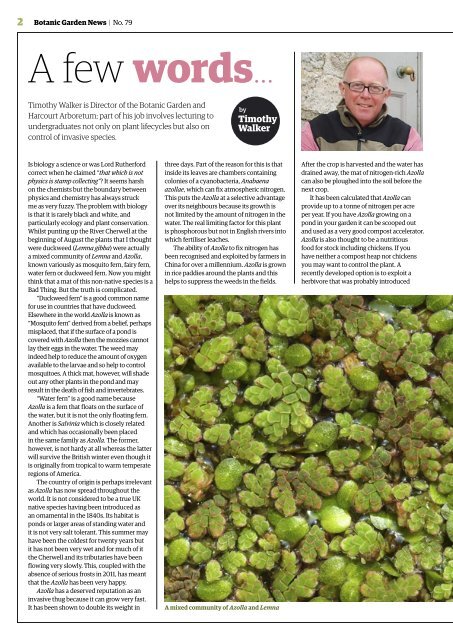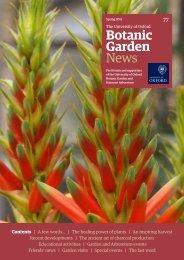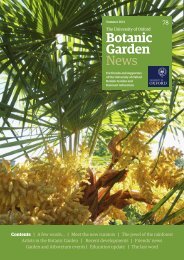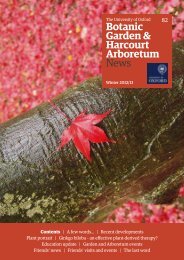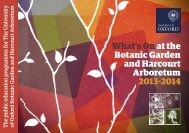Autumn/Winter 2011/12 - Harcourt Arboretum - University of Oxford
Autumn/Winter 2011/12 - Harcourt Arboretum - University of Oxford
Autumn/Winter 2011/12 - Harcourt Arboretum - University of Oxford
You also want an ePaper? Increase the reach of your titles
YUMPU automatically turns print PDFs into web optimized ePapers that Google loves.
2 Botanic Garden News | No. 79<br />
A few words...<br />
Timothy Walker is Director <strong>of</strong> the Botanic Garden and<br />
<strong>Harcourt</strong> <strong>Arboretum</strong>; part <strong>of</strong> his job involves lecturing to<br />
undergraduates not only on plant lifecycles but also on<br />
control <strong>of</strong> invasive species.<br />
by<br />
Timothy<br />
Walker<br />
Is biology a science or was Lord Rutherford<br />
correct when he claimed “that which is not<br />
physics is stamp collecting” It seems harsh<br />
on the chemists but the boundary between<br />
physics and chemistry has always struck<br />
me as very fuzzy. The problem with biology<br />
is that it is rarely black and white, and<br />
particularly ecology and plant conservation.<br />
Whilst punting up the River Cherwell at the<br />
beginning <strong>of</strong> August the plants that I thought<br />
were duckweed (Lemna gibba) were actually<br />
a mixed community <strong>of</strong> Lemna and Azolla,<br />
known variously as mosquito fern, fairy fern,<br />
water fern or duckweed fern. Now you might<br />
think that a mat <strong>of</strong> this non-native species is a<br />
Bad Thing. But the truth is complicated.<br />
“Duckweed fern” is a good common name<br />
for use in countries that have duckweed.<br />
Elsewhere in the world Azolla is known as<br />
“Mosquito fern” derived from a belief, perhaps<br />
misplaced, that if the surface <strong>of</strong> a pond is<br />
covered with Azolla then the mozzies cannot<br />
lay their eggs in the water. The weed may<br />
indeed help to reduce the amount <strong>of</strong> oxygen<br />
available to the larvae and so help to control<br />
mosquitoes. A thick mat, however, will shade<br />
out any other plants in the pond and may<br />
result in the death <strong>of</strong> fish and invertebrates.<br />
“Water fern” is a good name because<br />
Azolla is a fern that floats on the surface <strong>of</strong><br />
the water, but it is not the only floating fern.<br />
Another is Salvinia which is closely related<br />
and which has occasionally been placed<br />
in the same family as Azolla. The former,<br />
however, is not hardy at all whereas the latter<br />
will survive the British winter even though it<br />
is originally from tropical to warm temperate<br />
regions <strong>of</strong> America.<br />
The country <strong>of</strong> origin is perhaps irrelevant<br />
as Azolla has now spread throughout the<br />
world. It is not considered to be a true UK<br />
native species having been introduced as<br />
an ornamental in the 1840s. Its habitat is<br />
ponds or larger areas <strong>of</strong> standing water and<br />
it is not very salt tolerant. This summer may<br />
have been the coldest for twenty years but<br />
it has not been very wet and for much <strong>of</strong> it<br />
the Cherwell and its tributaries have been<br />
flowing very slowly. This, coupled with the<br />
absence <strong>of</strong> serious frosts in <strong>2011</strong>, has meant<br />
that the Azolla has been very happy.<br />
Azolla has a deserved reputation as an<br />
invasive thug because it can grow very fast.<br />
It has been shown to double its weight in<br />
three days. Part <strong>of</strong> the reason for this is that<br />
inside its leaves are chambers containing<br />
colonies <strong>of</strong> a cyanobacteria, Anabaena<br />
azollae, which can fix atmospheric nitrogen.<br />
This puts the Azolla at a selective advantage<br />
over its neighbours because its growth is<br />
not limited by the amount <strong>of</strong> nitrogen in the<br />
water. The real limiting factor for this plant<br />
is phosphorous but not in English rivers into<br />
which fertiliser leaches.<br />
The ability <strong>of</strong> Azolla to fix nitrogen has<br />
been recognised and exploited by farmers in<br />
China for over a millennium. Azolla is grown<br />
in rice paddies around the plants and this<br />
helps to suppress the weeds in the fields.<br />
A mixed community <strong>of</strong> Azolla and Lemna<br />
After the crop is harvested and the water has<br />
drained away, the mat <strong>of</strong> nitrogen-rich Azolla<br />
can also be ploughed into the soil before the<br />
next crop.<br />
It has been calculated that Azolla can<br />
provide up to a tonne <strong>of</strong> nitrogen per acre<br />
per year. If you have Azolla growing on a<br />
pond in your garden it can be scooped out<br />
and used as a very good compost accelerator.<br />
Azolla is also thought to be a nutritious<br />
food for stock including chickens. If you<br />
have neither a compost heap nor chickens<br />
you may want to control the plant. A<br />
recently developed option is to exploit a<br />
herbivore that was probably introduced


